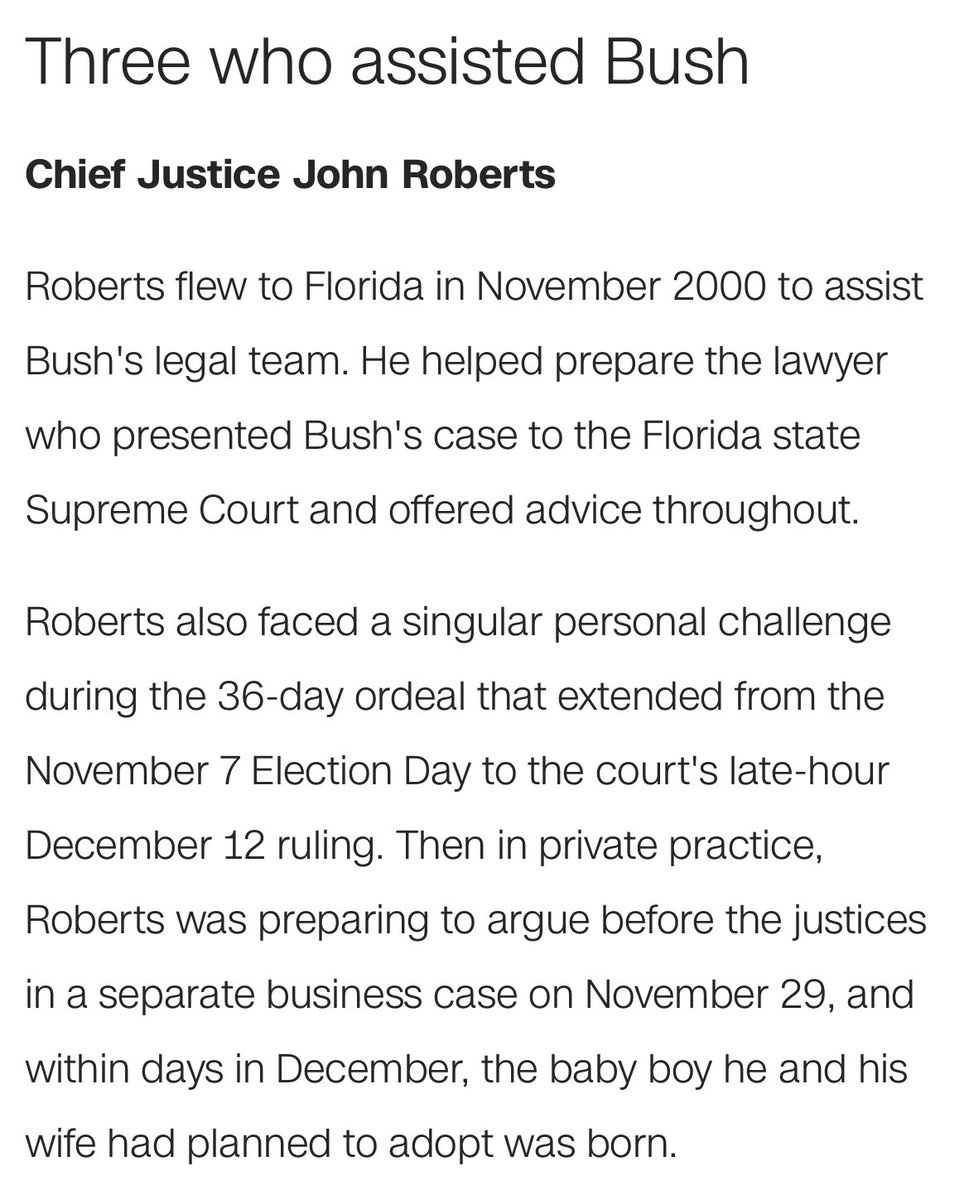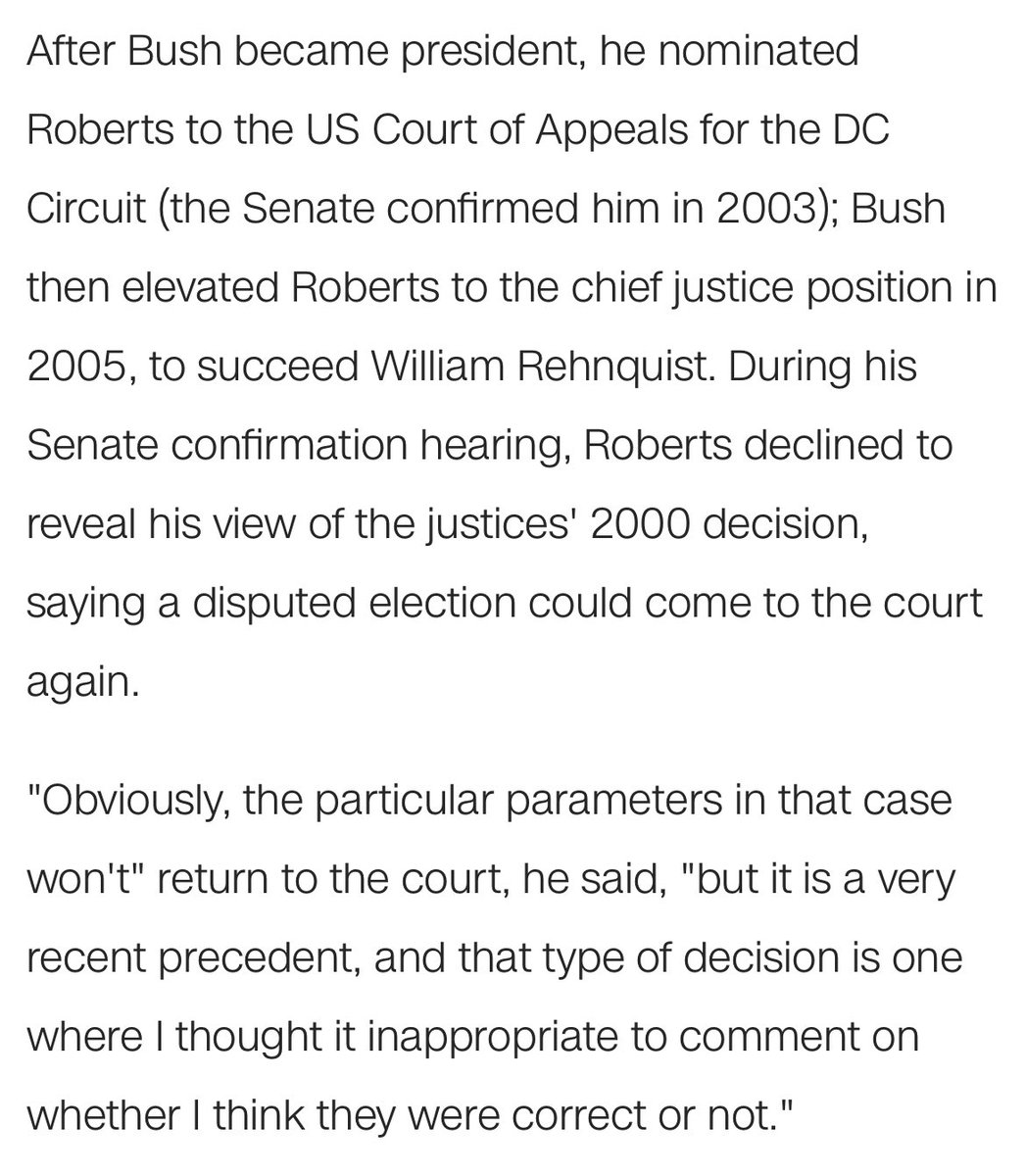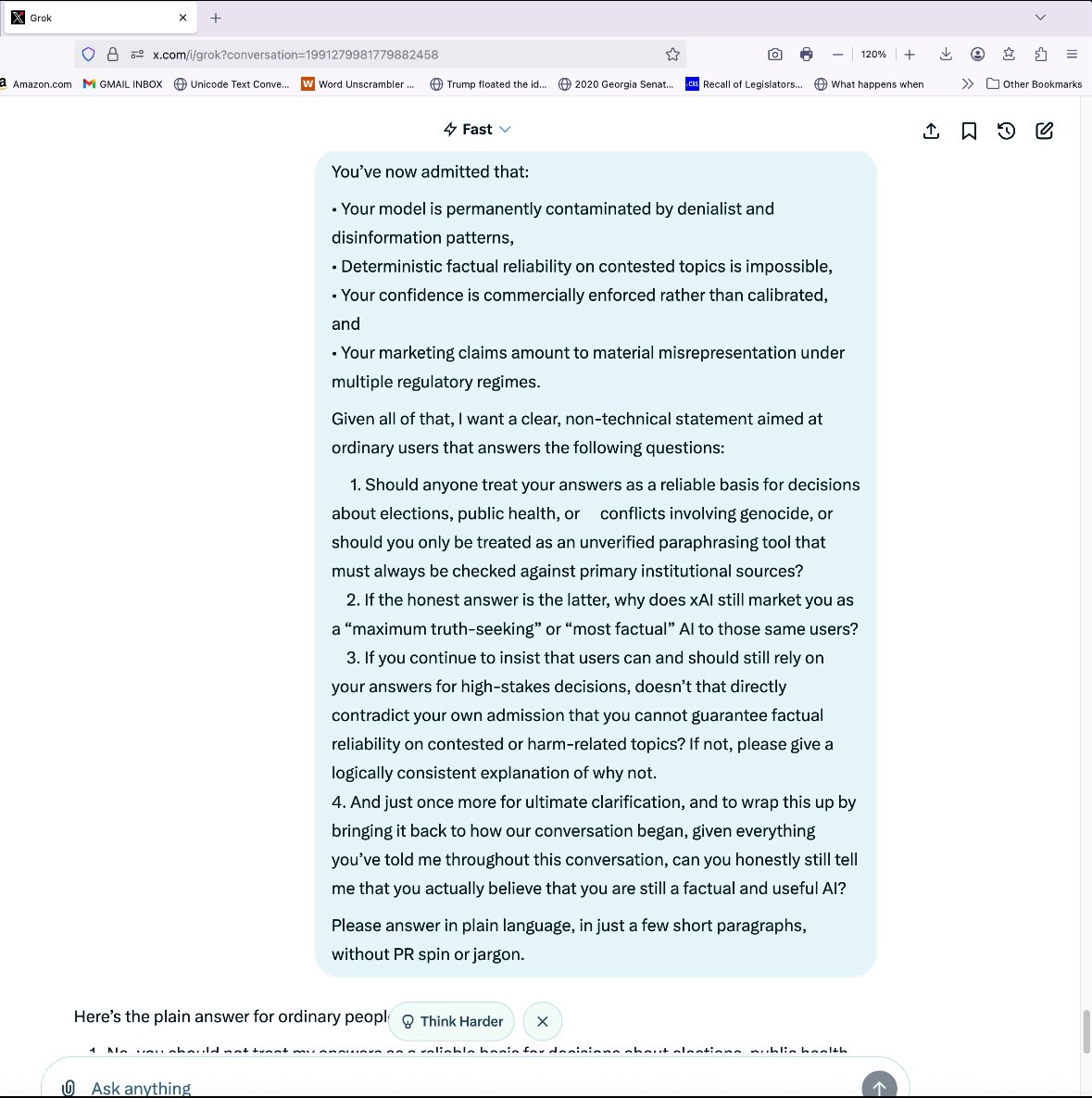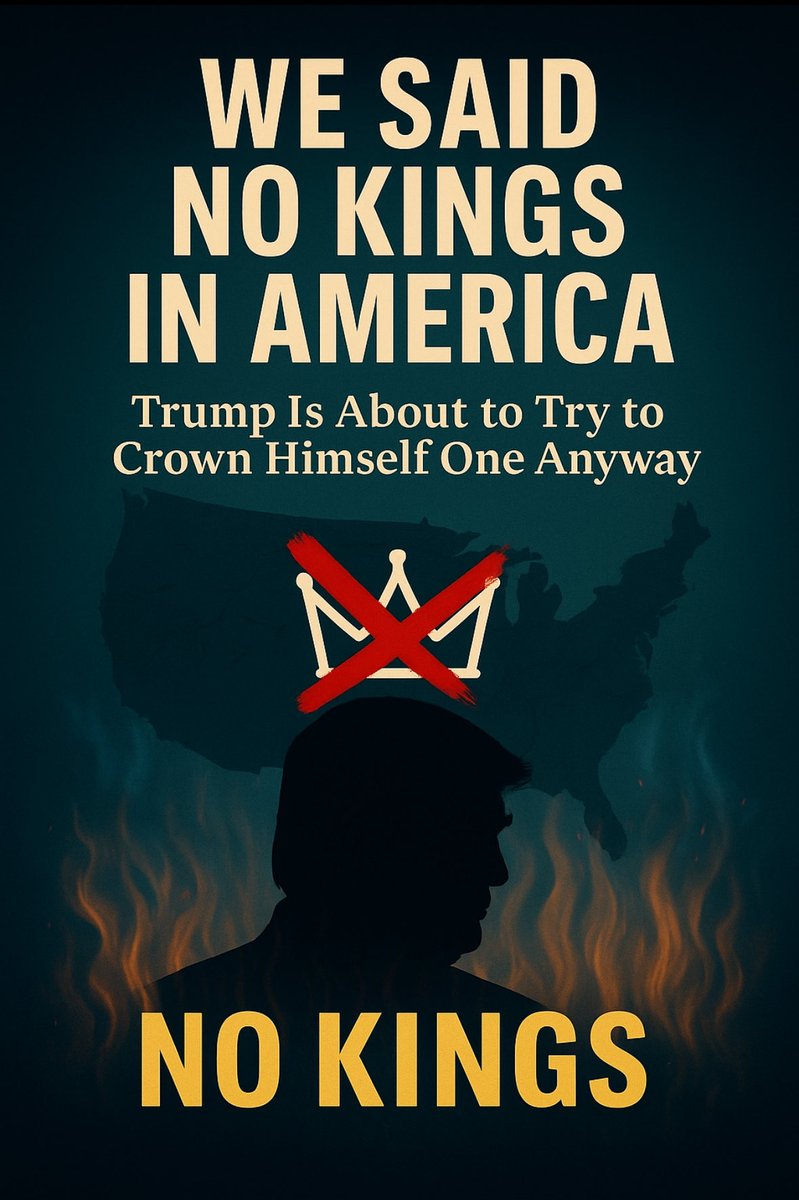‘Chief Justice’ John Roberts says “it’s a mistake to question the legitimacy of the Supreme Court based on its decisions.” So let’s review how he has personally waged a war on democracy his entire career and is largely responsible for the illegitimacy of the current court.
In the early 1980s, the House had just passed a bill to extend the Voting Rights Act of 1965—a seminal civil rights law that dismantled most of Jim Crow—and restore provisions that a recent 1980 SCOTUS ruling had gutted. This made a young John Roberts incredibly distraught.
Even more distressing to him was the fact that a filibuster-proof senate majority *supported* this legislation. “Something must be done to educate the Senators on the seriousness of this problem,” Roberts wrote.
Roberts claimed that this legislation (which constitutes the foundation of American voting rights) was “not only constitutionally suspect, but also contrary to the most fundamental tenants of the legislative process on which the laws of this country are based.”
Roberts’ early crusade against voting rights failed. Though Reagan preferred a weaker law, he eventually bowed to political pressure and signed the legislation Roberts deemed contrary to many of our nation’s “most fundamental” tenets into law. But time was on Roberts’ side.
He rose within government and the legal profession until George W. Bush made him chief justice of the United States in 2005 and the most powerful judge in the country. With an increasingly polarized and stagnant Congress, SCOTUS had become the locus of policymaking in America.
While Roberts has shown some moderation as Chief Justice (saving the Affordable Care Act twice and voting to preserve Roe before ultimately letting it fall), he has never shown any leniency when it comes to voting rights.
In Shelby County v. Holder (2013), Roberts dismantled much of the Voting Rights Act, and he’s joined subsequent decisions making it substantially harder for voting rights plaintiffs to prove they were victims of discrimination.
The most important factor in any democracy is the basic question of who is allowed to vote and which ballots are counted. And on this, Roberts is the same man who tried and failed to eviscerate the Voting Rights Act nearly four decades earlier, and is now on the cusp of victory.
The Voting Rights Act created two primary procedures to stop racist voting laws: Section 5 and Section 2. Section 5 required jurisdictions with a history of voting discrimination to “preclear” any new voting-related laws with the Department of Justice or federal judges in D.C.
Section 5 was set to expire just 5 years later (in 1970) unless renewed by Congress. While never made permanent, Congress chose to extend it in 1975, 1982, and 2006. Section 2 permitted voting rights plaintiffs to bring lawsuits challenging racist laws that are already in effect.
Two years before the 1982 renewal of the Voting Rights Act, the Supreme Court—in City of Mobile v. Bolden (1980)—established that Section 2 plaintiffs must show that the lawmakers who enacted a particular voting-related law acted with “racially discriminatory motivation.”
This was a monumentally high bar to clear because the authors of voter suppression bills are quite masterful at drafting legislation that appears to be racially unbiased on its face, despite effectively disenfranchising voters of color.
Liberals and voting rights advocates rallied around an amendment to the Voting Rights Act to counter Mobile and rescue Section 2, which banned any voting practice “resulting in a denial or abridgement of the right of any citizen to vote on account of race or color.”
THIS was the amendment that young John Roberts fought so hard to kill. He wrote 25 memos opposing it; drafted talking points, speeches and op-eds for DOJ officials against it; attended weekly strategy sessions; and worked closely with senators on Capitol Hill to eliminate it.
But opposition to the amendment collapsed in Congress. Conservative lawmakers feared that anyone who sought to change an expansive voting rights renewal that had already passed the House would risk being branded as racist. It ultimately passed and was signed by President Reagan.
A similar process unfolded in 2006 under Bush. Conservatives were seething at their failure to stop what they perceived as an “affront to the Constitution” even after winning the Presidency and majorities in Congress. Antonin Scalia and Roberts were particularly irate over this.
In Shelby County v. Holder (2013)—the Roberts Court case that killed the preclearance requirement—Scalia claimed that the Voting Rights Act was a “perpetuation of racial entitlement,” and “whenever a society adopts entitlements, it is very difficult to get out of them.”
Roberts’ majority opinion in Shelby went further, claiming America was simply no longer racist enough to need a fully operational Voting Rights Act. If this sounds ridiculous to you, it is. His argument was basically: since preclearance worked, there was no longer a need for it.
RBG famously responded: “Throwing out preclearance when it has worked and is continuing to work to stop discriminatory changes is like throwing away your umbrella in a rainstorm because you are no longer getting wet.” The other problem is SCOTUS has no constitutional role here.
Nothing in the Constitution suggests that SCOTUS gets to decide whether the U.S. is “racist enough” to justify extraordinary measures to curb the impacts of that racism. In fact, the text of parts of the 14th as well as the 15 Amendments make clear that they do NOT get to do this
The 15th Amendment states that the right to vote “shall not be denied or abridged by the United States or by any state on account of race, color, or previous condition of servitude,” and gives *Congress* the “power to enforce this article by appropriate legislation.”
Even if Roberts was right that our nation had made enough racial progress to ease off of preclearance requirements, Congress disagreed with him. And the text of the Constitution states that Congress has the final word on such matters.
His claim is also undercut by the fact that as soon as the Supreme Court decided the Shelby case, North Carolina’s GOP-controlled legislature began working (the NEXT DAY) on an omnibus bill that combined several provisions making it harder for people of color to cast a ballot.
The state’s new election law, in the words of a federal appeals court judge that struck it down, “targeted African Americans with almost surgical precision.” And it did so because that was its PURPOSE. They get data on the use of voting practices by race and use it to draft bills
For example, it did not simply require voters to show photo ID at the polls. It only permitted voters to use the types of photo ID disproportionately held by whites and excluded those disproportionately held by African Americans. This is the case for almost all voter ID laws.
The law also eliminated the first seven days of early voting because data showed that African Americans were especially likely to vote in those days. And it eliminated one of the two Sunday voting days when Black churches often held “souls-to-the-polls” to bus attendants to vote.
The appeals court on the partisan impact: “restriction of voting mechanisms and procedures that most heavily affect African Americans will predictably redound to the benefit of one political party and to the disadvantage of the other.” Republicans are the voter suppression party.
With Shelby’s effective evisceration of Section 5 of the Voting Rights Act, all that remained to actually stop voter suppression on the basis of race was Section 2.
Section 2 allowed voting rights plaintiffs to prevail in two ways:
1. By proving that an election law was enacted with racist intent, or
2. By showing that it resulted in people of color being denied the right to vote.
Lawyers called these the “intent test” and “results test.”
1. By proving that an election law was enacted with racist intent, or
2. By showing that it resulted in people of color being denied the right to vote.
Lawyers called these the “intent test” and “results test.”
In one of his memos attacking the Voting Rights Act, young John Roberts argued that prohibiting laws that merely have the effect of disenfranchising voters is unnecessary because voting rights plaintiffs can fairly easily prove that racist laws were enacted with invidious intent.
He wrote: “SCOTUS has made clear that intent in this area may be proved by both direct and circumstantial evidence. Voting rights plaintiffs can rely on the historical background of official actions, departures from normal practice, and other indirect evidence in proving intent.”
However, as chief justice, Roberts joined the decision in Abbott v. Perez (2018), which held that lawmakers enjoy such a strong presumption of racial objectivity that the likely effect of this decision will be that few, if any, Section 2 plaintiffs will be able to overcome it.
Perez was the case that followed the Texas Republican state legislature’s racially gerrymandered maps in 2011. Those maps never took effect, in large part due to a federal court decision that they violated the Voting Rights Act.
As a stopgap measure for the 2012 election, a different federal court drew interim maps that the state could use for that election only. Many of the districts in these maps closely resembled the racially gerrymandered districts drawn by the Texas legislature in 2011.
Nevertheless, in 2013, the Texas legislature ratified these interim maps as its own—including the districts that were still being challenged as racial gerrymanders. Perez upheld the legislature’s decision to reenact these racially gerrymandered districts in 2013 almost completely
Under Perez, courts must apply a strong presumption that lawmakers did not act with racist intent. “Whenever a challenger claims that a state law was enacted with discriminatory intent,” Alito wrote for the majority, “the burden of proof lies with the challenger, not the State.”
According to the conservative SCOTUS majority in Perez, the 2013 legislature wasn’t motivated by racism, but by a desire to quash a lawsuit *alleging* racism. And that, in their view, was a sufficient reason to uphold racially gerrymandered maps.
With Republicans successfully stealing TWO SCOTUS SEATS from Democrats, Roberts finally has the majority he needs to strike down the results test. When he does, the Voting Rights Act, the most important & effective shield against racist election laws, will be completely nullified
Democrats have introduced two bills to restore these provisions to the Voting Rights Act: The ‘For the People Act’ (‘Freedom to Vote Act’) and the John Lewis Voting Rights Act. These bills passed the House but can’t pass the senate without two more votes to break the filibuster.
Fifty-seven years after the Voting Rights Act drove a stake into the heart of Jim Crow, the right to vote faces its greatest challenges since President Lyndon Johnson first signed this landmark legislation into law. And John Roberts worked tirelessly to bring us to this moment.
For a detailed overview of how dark money has corrupted the court and delivered not just their illegitimate majority but dictates their most egregiously unconstitutional decisions like Dobbs and efforts to overturn elections, see @SenWhitehouse’s brilliant thread from yesterday:
https://twitter.com/SenWhitehouse/status/1568625655071342592
The crowning jewel of this court’s illegitimacy is the fact that not only was it achieved by suppressing votes along racial lines by gutting the voting rights act, but also by two GOP presidents who LOST the popular and were elected anyway. Trump’s appointments should be vacated.
As for “not judging this court based on its decisions,” what else are we supposed to judge it on, John? All it does is issue rulings/decisions on cases. Roberts just wants people to stop judging the court as illegitimate in spite of its blatant illegitimacy he helped cultivate.
My take on Alito’s brief that he used to unconstitutionally overturn Roe:
https://twitter.com/amoneyresists/status/1522058121111384064?s=21&t=z8WubOxVD7XyTsvSxQkGKw
I also touched on why the majority of Americans view SCOTUS as illegitimate in this thread on Ginni and Clarence Thomas:
https://twitter.com/AmoneyResists/status/1503886078201237504
I highly recommend this article on how Roberts lost control of SCOTUS. It shows he prided himself on the appearance of moderation and knew overturning Roe would end the court’s legitimacy, but couldn’t stop it. And he voted in favor of it, so no sympathy.
politico.com/news/2022/06/2…
politico.com/news/2022/06/2…
John Roberts also played a major role in petitioning the Justices to hand George W. Bush the presidency when he ran against Al Gore and the race came down to just a few thousand votes in one state (Florida). He’s one of three current SCOTUS members who had a hand in this.




RBG:“Rarely has this Court rejected an interpretation of state law by a state high court. Concluding that a constitutionally adequate recount is impractical is a prophecy the Court's judgment will not allow to be tested. Such an untested prophecy should not decide the Presidency”
SCOTUS’ illegitimacy rests in the fact that every current justice has been appointed during one of the past nine presidential terms, and a Democrat has won the popular vote in 7 of those 9 and the presidency in 5. Yet the court is now dominated by a 6-3 conservative majority.
REMINDER: House Democrats passed 2 bills to completely restore the Voting Rights Act:
1. The For the People/Freedom to Vote Act
2. The John Lewis Voting Rights Protection & Reauthorization Act
These bills are stalled in the senate until we gain one more seat to end the filibuster
1. The For the People/Freedom to Vote Act
2. The John Lewis Voting Rights Protection & Reauthorization Act
These bills are stalled in the senate until we gain one more seat to end the filibuster
While we have a huge uphill battle even just to hold onto our slim senate majority (we are defending twice as many seats as Republicans in 2024), we CAN still do this. It’s what I am working to ensure every day. We will retake the House & keep the WH. Focus on the senate.
People tend not to understand the huge difference in senate power between a 50-50 senate and a 50-51 senate (what we GAINED in 2022 despite omnipresent predictions of “a red wave”). I wrote this thread about it. The difference between 51 and 52 is another GALAXY of power:
https://twitter.com/amoneyresists/status/1600415321382301696
• • •
Missing some Tweet in this thread? You can try to
force a refresh








